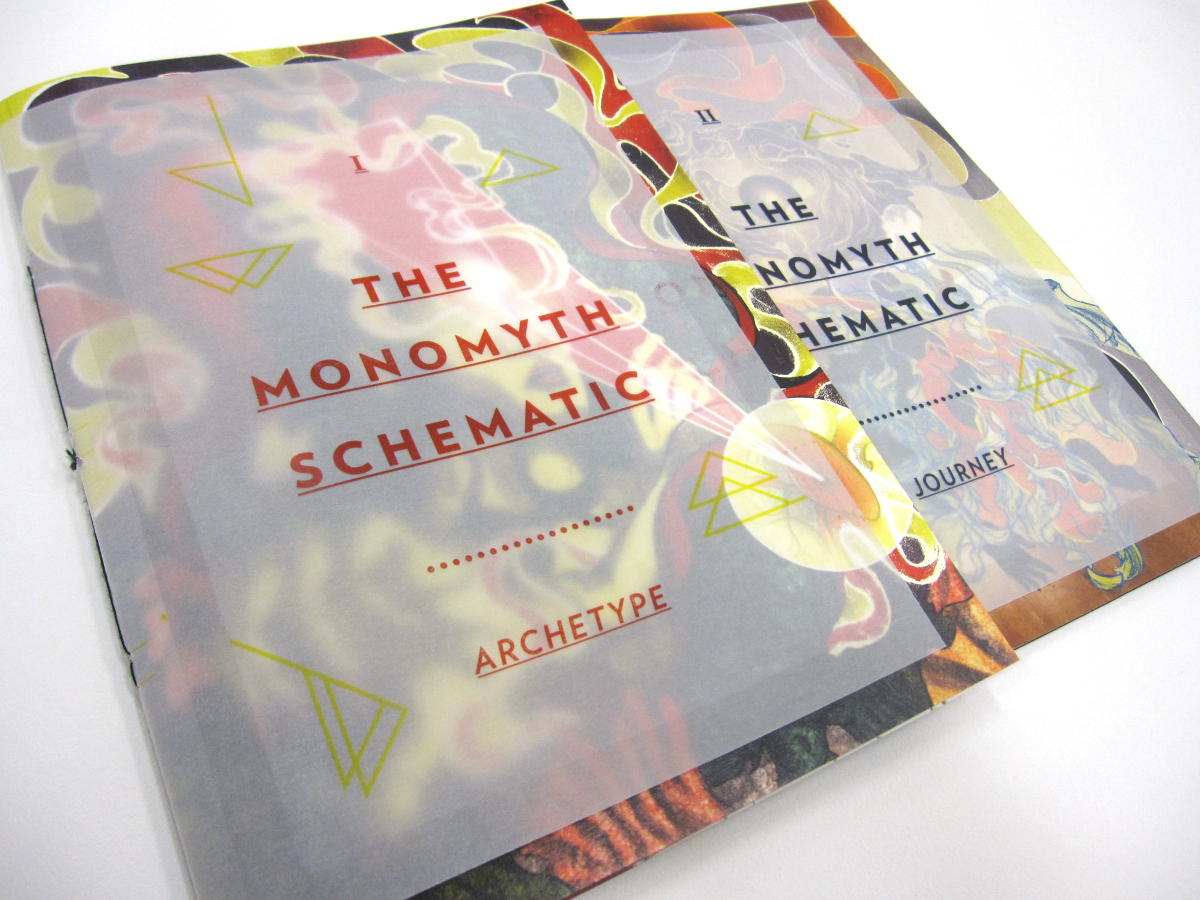The Monomyth Schematic Redux
The Monomyth Schematic is a two-part project which derives from the concept of the “Monomyth”, inspired by the work & writings of Carl Jung, Joseph Campbell & Christopher Vogler. It is an illustrated and interpretive approach to mapping the perennial trends and patterns within the world of storytelling & narrative as metaphors for human existence.
The research focus and visualisation of the project is performed along two parameters—the collection & the metaphor. It presents, in visual form, a systematic sequence of “schematics” which serve as the framework for narrative conceptualisation and creation. These are separated into two artists’ books which covers the topics of Character (Archetype) and Storyline (Journey). The content for both books comprises a collection of schematic form drawings and interpretive illustrations to accompany the written research outcome.
The Monomyth Schematic I—Archetype
The first book examines and dissects the essential characters in narrative by looking into character archetypes as well as the psychological framework. The content contained therein is largely inspired by the work of Carl Jung. Studying different aspects of the psychological frameworks leads to the identification of character archetypes—metaphors for the extremes of personality and the human psyche.
Character
This section deals with the seven character archetypes in storytelling and narrative. They are the Hero, Mentor, Trickster, Herald, Threshold Guardian, Shapeshifter and the Shadow.
Archetype +
A smaller format insert which features a collection of short stories from Greek Mythology to further explain the concepts discussed within the book—an intermission to the systematic presentation of schematics.
Psychology
Second part of the book which deals with the psychological framework as outlined by Carl Jung. They cover four aspects of the human mind—The Self, The Anima/Animus, The Shadow & The Persona. The characters in stories are highly relatable when they represent different aspects of personality as metaphors for the human mind.
The Monomyth Schematic II—Journey
The second book covers the topic of “The Hero’s Journey”. It is arguably a narrative metaphor for the human experience of circumstances faced in life. Largely inspired by the work of Joseph Campbell, the same plan-form approach is used to present the various stages of this “Journey”. A collection of quotes from Campbell, grounded in real life are related to visual representations of common metaphorical expression, together explaining the concepts contained within each stage of the Hero’s Journey.
Act One
The 5 introductory stages of a story—The Ordinary World, Call to Adventure, Refusal of the Call, Meeting the Mentor, Crossing the 1st Threshold.
Journey +
A full colour elaboration of common metaphorical expressions. The expressions, grounded in real life, complement Campbell’s quotes throughout the book, but are illustrated in fantastical fashion when interpreted as visual metaphors.
Act Two
The climax of the story—Tests, Allies & Enemies, Approach to the Innermost Cave, The Supreme Ordeal, Seizing the Sword.
Act Three
The conclusion to the Journey/Experience, marking consolidation, closure and insight for the Hero—The Road Back, Resurrection, Return with the Elixir.
The Hero’s Journey, just like the characters contained within it, is not a mere figments of mythology. It is a metaphor for human existence and the events which constitute it. Narratives are adaptations, exaggerations and stylisations of life. Here, they are dissected visually and conceptually from various angles and perpsectives.
Collections and Metaphors
Character Archetypes and stages of the Hero’s Journey are illustrated and presented in plan-form, a collection of passages, quotes and images which are a visual interpretation of Christopher Vogler’s toolkit for writers. The illustrations are compositions of visual metaphors which relate to respective concepts, and the project itself is a metaphor for the constants which exist in real-life, and seeks an understanding of this blueprint to aid in the construction of more meaningful narratives. The mode of representation is subject to the discretion of the writer, yet maintaining a degree of adherence to narrative frameworks will allow for greater relevance.
Illustrations
In seeking a personal voice, I decided that the project would be visually driven by Illustration. I saw the idea of the “collection” and the “metaphor” as parameters along which I could attempt to enhance my technical and conceptual ability—by producing a visually unified body of work quickly as well as inject conceptual and metaphorical meaning into the illustrations.
Teaching Faculty
DV3008 – Visual Communication IV
Graphic design, Illustrated book
Hedren Sum Wai Yuan
27 March 2015
29 April 2017
Copyright. All rights reserved.
Share


















































